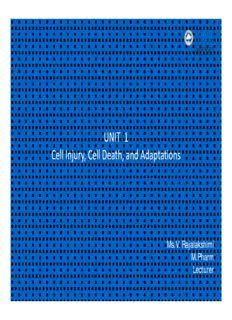
Cell Injury, Cell Death, and Adaptations PDF
Preview Cell Injury, Cell Death, and Adaptations
UNIT 1 Cell Injury, Cell Death, and Adaptations Ms.V. Rajalakshimi M.Pharm Lecturer Introduction to Pathology (cid:121) Vocabulary (cid:121) Pathology (cid:121) Literally it is the study of suffering (cid:121) What happens to tissues/organs of the body in the presence of disease (cid:121) Disease (cid:121) Literally a “lack of ease” (cid:121) Pathological process of the body organ(s) with its’ own signs and symptoms (cid:121) Dysfunction of significant number of cells in the organ must occur first – Disorder • Organ is normal but malfunction of the organ exists • Disease may or may not be present – Sickness • The physical and/or mental state of being “unwell” • Can be due to emotions, background, inheritance self image, presence or absence of psychiatric problems, etc. Introduction to Pathology • Vocabulary – Health • Well being state indicating normality of body, mind and spirit • Origin in health cells in tissues and organs – Sign • Observable “objective” or measurable physical manifestations of disease(s) or disorder(s) Introduction to Pathology – Symptom • “Subjective” evidence of a disease or disorder – Diagnosis • Attachment of a specific name to a specific disease or disorder • Summation of signs, symptoms, tissue changes, chemistry, physiology or function changes unique to that disease or disorder Introduction to Pathology (cid:121) Vocabulary (cid:121) Prognosis (cid:121) Making a prediction of the outcome of a disease or disorder (cid:121) Therapy (cid:121) Treatment of a disease or disorder (cid:121) Several components (cid:121)Supportive – lenses (cid:121)Restorative – VT (cid:121)Physical agents – laser (cid:121)Chemical – medications (cid:121)Surgical Introduction to Pathology – Etiology • The “cause of” a disease or disorder – Pathogenesis • Underlying mechanisms resulting in the signs and symptoms of the patient – Morphology • Gross or microscopic appearance of cells and tissues • For a disease or disorder to become manifested clinically, there first must be a dysfunction of a significant number of cells in an organ or tissue Overview of Cellular Responses to Stimuli • Cells operate in a very narrow range of physiologic parameters – they maintain homeostasis • Homeostasis – equilibrium of the microenvironment of the cell – Chemical – electrolytes, glucose, pH, etc. – Physical – temperature, etc. Overview of Cellular Responses to Stimuli • Constantly adjust their structure and function adapting to their altered environment • Adaptation – adjusting to a new situation to preserve viability and function • Stress – pathological definition – any demand on the cell requiring it to adapt Overview of Cellular Responses to Stimuli • Inability to adapt will compromise the cell and result in injury and possibly death • Principle adaptive responses – Hypertrophy – Hyperplasia – Atrophy – Metaplasia
Description: